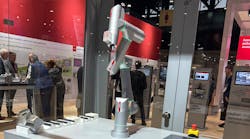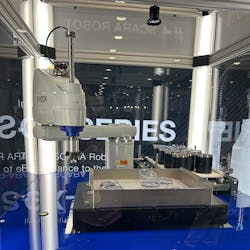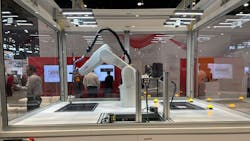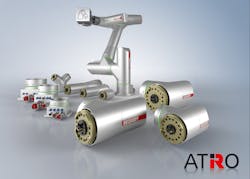Robotics on the Rise in Packaging and Processing Applications
I recently had the opportunity to attend PACK EXPO International 2022, an event showcasing the latest solutions for packaging and processing hosted by PMMI, the Association for Packaging and Processing Technologies.
Doing so provided me with an opportunity to learn more about a segment of the industry served by fluid power, particularly pneumatics, and motion control that I was not yet as familiar with as well as the chance to see a variety of technologies first hand.
A key theme among many exhibitors was increased automation through various technologies, particularly robots. Workforce challenges were of course noted among the reasons for the growing need for robots in packaging and processing applications as was the desire to help improve productivity for customers.
READ MORE about PACK EXPO from our colleagues at Machine Design:
Pack Expo Product Debuts Highlight Open Systems
Pack Expo 2022 is a Meeting of the Minds
New Robots Bring Efficiency Gains
Several companies showcased their latest robot designs during PACK EXPO, many of which were designed to maneuver quickly, thus helping customers to increase their productivity and efficiency.
Epson Robots for instance, showed its recently launched GX Series SCARA robot. It features larger motors which the company explained helps to provide more speed for pick and place and other applications. This enables end-use customers to get more work done during the day.
Additional features of the robot include a vision system for optimized picking of parts and a small form factor to easily fit into constrained spaces. Several mounting options are available to provide flexibility for customers and versions for clean rooms and medical applications are available as well.
ABB previewed its soon-to-be-launched robotic item picker which runs on a deep learning artificial intelligence (AI) algorithm developed by the company. In addition to the AI software, the robot utilizes ABB's motion planning and the latest in machine vision techniques explained Ali Raja of ABB during an interview with Power & Motion at PACK EXPO.
By combining these three technologies, he said the robot is able to provide the highest capacity picks per hour. Raja said the robot on display could do up to 1,500 picks per hour at peak capacity while handling randomly sized and shaped products. Also aiding its speed is the use of a proprietary technique in the end of arm tool that allows quick movements as soon as something is picked up.
Increasing picking capacity has been a trend in the industry, said Raja. However, he noted while increased speed or picking capacity is important so too is the reliability of the robot which may not always be considered during development. You may have the fastest robot, but if it breaks down frequently then customers will not be achieving the productivity gains they may have hoped for; as such, he said ABB put a lot of focus on ensuring reliable autonomous operation of the new robot.
Bechkoff also previewed a new robot (see image at beginning of article) it plans to bring to market, known as ATRO, which will be the company's first. Though the company has supplied products for use in various robots, at PACK EXPO it showed its own in-house designed and manufactured robot arm.
One of the biggest benefits is the robot's modularity. The company offers a standard set of robot modules which customers can use to shape the robot how they see fit for their application. It is even possible to have two robot arms with different shapes; it is completely up to customers how they decide to shape the robot arm the company said during an interview with Power & Motion at PACK EXPO.
Ease of Use is Vital
A key feature Beckhoff pointed out about its new robotic arm is the fact it is easy to set up by connecting some joints, turning a slip ring and tightening a few bolts. To set the movements of the robot, customers can physically move the appropriate points and set them in a user interface. Customers can then begin using the robot which remembers those set movements.
The subject of ease of use and set up for robots was a common one throughout discussions at PACK EXPO with many companies looking to do so by transitioning towards more configuration than programming of robots. Doing so helps to reduce any learning curves and optimize the productivity so many companies require. Automation solutions like robots are meant to ease the workload but can only do so if they are in fact easy to use.
READ MORE: “Making Automation Easy Starts With the Design Process”
For its robots, Epson has introduced its new RC+ Express software designed to make it easy to program robots. Essentially, users can drag and drop desired functionalities for the company's robots to perform, enabling easy set up and a lower learning curve as no complex coding is required.
With the deep learning AI built into ABB's robotic item picker, Raja said there is no need to teach the robot how to handle products of various shapes and sizes. With the AI, the robot can essentially pick up anything even if it has not handled something previously of the same shape or size. And the more it handles similar types of products the more it learns how to accurately do so, adapting and evolving without the need for human interaction.
Use of robots is expected to continue growing in manufacturing as a means of assisting workers as well as doing jobs for which it has become difficult to find employees. As such, making them easy to use and implement will help to increase their uptake in the market while enabling manufacturers to be more productive and better able to meet the current strong demand for various goods.
READ MORE: The Future of Manufacturing and its Impacts on Workforce Development
We want to hear from you!
What new robotic technologies are you seeing enter the market? What skills are needed to use the robots and other automation technologies entering the field? How will the use of robots continue to progress?
Let us know! Email me at [email protected] or reach out to us on social media.
Twitter: @TechnlgyEditor or @PowerMotionTech
LinkedIn: @PowerMotionTech





